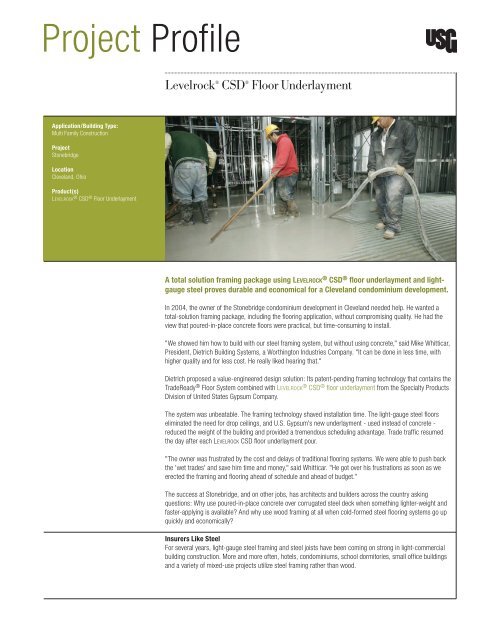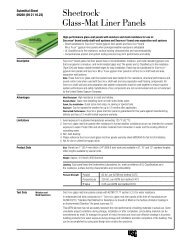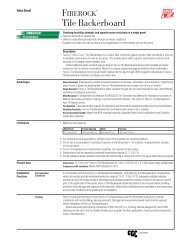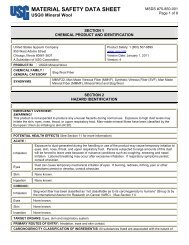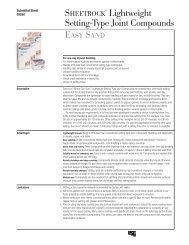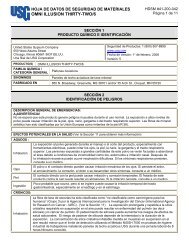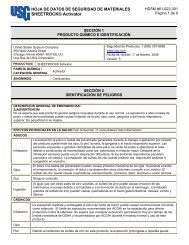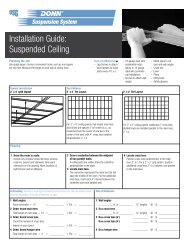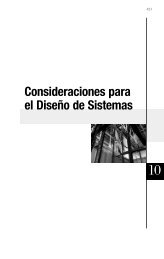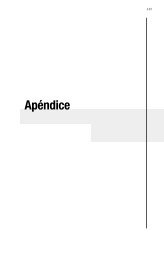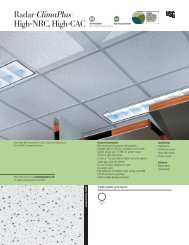LEVELROCK® CSD Floor Underlayment Project Profile - Stonebridge
LEVELROCK® CSD Floor Underlayment Project Profile - Stonebridge
LEVELROCK® CSD Floor Underlayment Project Profile - Stonebridge
Create successful ePaper yourself
Turn your PDF publications into a flip-book with our unique Google optimized e-Paper software.
<strong>Project</strong> <strong>Profile</strong><br />
Application/Building Type:<br />
Multi Family Construction<br />
<strong>Project</strong><br />
<strong>Stonebridge</strong><br />
Location<br />
Cleveland, Ohio<br />
Product(s)<br />
LeveLrock ® <strong>CSD</strong> ® <strong>Floor</strong> <strong>Underlayment</strong><br />
Levelrock ® <strong>CSD</strong> ® <strong>Floor</strong> <strong>Underlayment</strong><br />
A total solution framing package using LeveLrock ® <strong>CSD</strong> ® floor underlayment and lightgauge<br />
steel proves durable and economical for a Cleveland condominium development.<br />
In 2004, the owner of the <strong>Stonebridge</strong> condominium development in Cleveland needed help. He wanted a<br />
total-solution framing package, including the flooring application, without compromising quality. He had the<br />
view that poured-in-place concrete floors were practical, but time-consuming to install.<br />
"We showed him how to build with our steel framing system, but without using concrete," said Mike Whitticar,<br />
President, Dietrich Building Systems, a Worthington Industries Company. "It can be done in less time, with<br />
higher quality and for less cost. He really liked hearing that."<br />
Dietrich proposed a value-engineered design solution: Its patent-pending framing technology that contains the<br />
TradeReady ® <strong>Floor</strong> System combined with LeveLrock ® <strong>CSD</strong> ® floor underlayment from the Specialty Products<br />
Division of United States Gypsum Company.<br />
The system was unbeatable. The framing technology shaved installation time. The light-gauge steel floors<br />
eliminated the need for drop ceilings, and U.S. Gypsum's new underlayment - used instead of concrete -<br />
reduced the weight of the building and provided a tremendous scheduling advantage. Trade traffic resumed<br />
the day after each LeveLrock <strong>CSD</strong> floor underlayment pour.<br />
"The owner was frustrated by the cost and delays of traditional flooring systems. We were able to push back<br />
the 'wet trades' and save him time and money," said Whitticar. "He got over his frustrations as soon as we<br />
erected the framing and flooring ahead of schedule and ahead of budget."<br />
The success at <strong>Stonebridge</strong>, and on other jobs, has architects and builders across the country asking<br />
questions: Why use poured-in-place concrete over corrugated steel deck when something lighter-weight and<br />
faster-applying is available? And why use wood framing at all when cold-formed steel flooring systems go up<br />
quickly and economically?<br />
Insurers Like Steel<br />
For several years, light-gauge steel framing and steel joists have been coming on strong in light-commercial<br />
building construction. More and more often, hotels, condominiums, school dormitories, small office buildings<br />
and a variety of mixed-use projects utilize steel framing rather than wood.
For big developers who build many structures each year, light-gauge steel offers the ability to build five to eight<br />
stories economically," said John Mandel, market manager for U.S. Gypsum's Specialty Products Division. "One<br />
of the other advantages of steel is that it is noncombustible, and many insurers are advocating its use."<br />
Architects and developers find that steel opens doors to greater design flexibility and cost savings.<br />
Pre-engineered, panelized light steel framing, for example, can be installed in irregular-shaped buildings.<br />
Light-steel floor joists speed up project schedules, and poured underlayments save time.<br />
The inherent strength of lightweight poured underlayments also provides key benefits. LeveLrock <strong>CSD</strong> floor<br />
underlayment, for example, provides 3500 to 4500 psi compressive strength, allowing it to be applied at<br />
much lower thicknesses than poured-in-place concrete.<br />
"The advantage from a material standpoint is cost, but significant savings are achieved due to its lower<br />
weight," said Mandel. "Since LeveLrock underlayment weighs only 12.8 pounds per square foot, architects<br />
have greater design flexibility and the potential to build higher structures."<br />
Conventional concrete requires a pour of 3 inches or more. LeveLrock <strong>CSD</strong> floor underlayment, on the other<br />
hand, requires only 1-9/16 inches from the bottom of the corrugated steel deck fluting to 1 inch over the crest<br />
of the flute. Less material means less overall weight and less setting time. A concrete pour requires seven to<br />
10 days before resuming trade traffic (28 days to cure fully), while a LeveLrock <strong>CSD</strong> floor underlayment pour<br />
handles sub-trades within 24 hours.<br />
"No other flooring manufacturer has a product formulated for steel that pours right onto the diaphragm, is UL<br />
listed and has sound attenuation properties that exceed International Building Code standards," said Mandel.<br />
As more projects convert from wood framing to light-gauge steel, LeveLrock <strong>CSD</strong> floor underlayment is helping<br />
to pave the way.<br />
• Dietrich Building Systems, for example, recently used LeveLrock <strong>CSD</strong> floor underlayment in the construction<br />
of the Parkview Condominiums, a high-end project in Columbus, Ohio. The new underlayment was chosen to<br />
deliver the look and feel of concrete and provide high performance, but with less weight and cost.<br />
"LeveLrock <strong>CSD</strong> underlayment allows us the ability to reduce construction time. Our clients save money on<br />
insurance costs and open their building quicker," said Whitticar. "Imagine how much money a 120-room hotel<br />
generates when they can open 10, 20 or 30 days quicker. That money goes straight to the bottom line."
• Pymer Plastering Inc., Columbus, Ohio, recently poured LeveLrock <strong>CSD</strong> floor underlayment in a six-story<br />
condominium project in Columbus. Company officials said that the sub-trades were impressed with the<br />
hardness and evenness of the surface, and were surprised to be working on the underlayment the day after<br />
it had been poured. Most flooring installations put tradesmen off a job for days or even weeks, but LeveLrock<br />
<strong>CSD</strong> floor underlayment sets up quickly. It can significantly streamline the trade scheduling.<br />
"I spoke to a number of subcontractors after one pour, and they were amazed," said Sherry Pymer, Vice<br />
President, Pymer Plaster. "LeveLrock <strong>CSD</strong> underlayment doesn't chalk, flake or gouge like the other poured<br />
gypsum underlayments they know."<br />
It's not often that new products revolutionize design and construction practices. Yet LeveLrock <strong>CSD</strong> floor<br />
underlayment and light steel joist systems have created a real buzz among architects, builders and contractors.<br />
But more than just talk, steel framing and poured gypsum underlayment are being used on more and more<br />
projects. It seems the new systems are here to stay.<br />
"We've used USG products as a company for more than 100 years, and we know their reputation for quality<br />
and for doing their homework," said Pymer. "I'm convinced the company is onto something big by producing an<br />
underlayment that can be used with corrugated steel decking. These systems are the wave of the future."<br />
Manufactured by<br />
United States Gypsum Company<br />
550 West Adams Street<br />
Chicago, IL 60661<br />
800 USG.4YOU (874.4968)<br />
levelrock.com<br />
usgdesignstudio.com<br />
10-09<br />
© 2009, United States Gypsum Company<br />
Printed in U.S.A.


